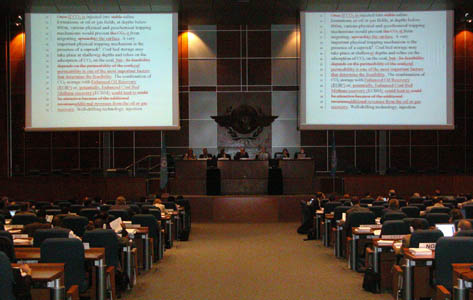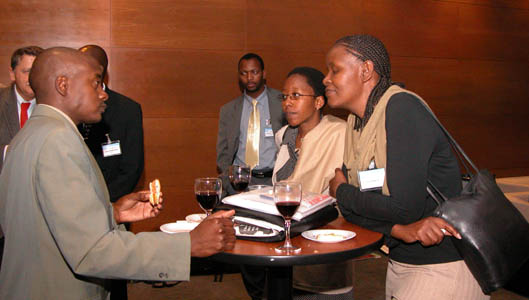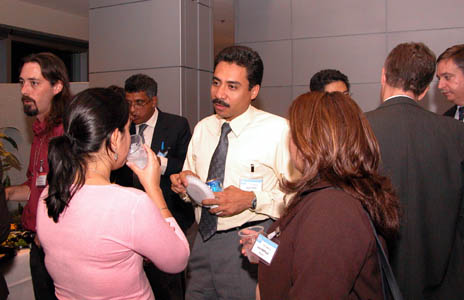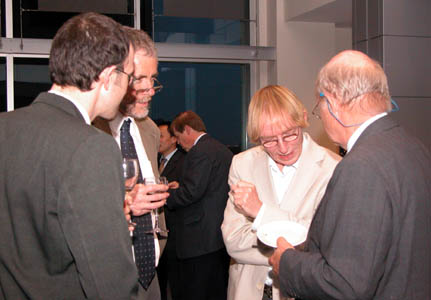|
|
|
CONSIDERATION
OF THE DRAFT SUMMARY FOR POLICYMAKERS
|
|
|
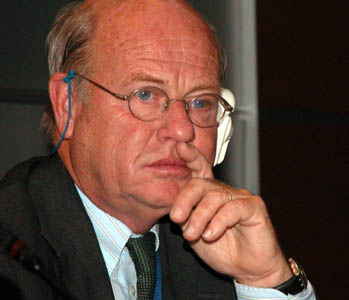
|

|
|
Co-Chair
Bert Metz (The Netherlands) welcomed delegates,
recalled that the SPM had already gone through an extensive
review process, and urged them to move forward to complete its
approval.
|
Lead
Author Richard Doctor with Co-Chair Ogunlade Davidson (Sierra Leone)
and Co-Chair
Bert Metz (The Netherlands).
|
|
|
What is the current
status of CCS technology?
|
|
|
|
|
|
|
|
|

|

|
|
BELGIUM
noted that a figure representing capture systems was unclear,
and proposed using a figure from the Special Report instead.
Above photo: J.P. van Ypersele (Belgium)
|
On the corrosiveness of pipelines for transportation, CANADA
proposed removing reference to hydrogen sulphide given its
negative connotation, and proposed referring to contaminants
instead.
Above
photo L-R: Anne-Marie Thompson and Bill Reynen
(Canada)
|
|
|
|
|

|
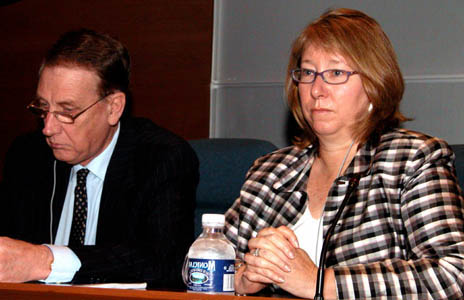
|
|
DENMARK,
supported by the UK and the NETHERLANDS, proposed emphasizing caprock as an essential trapping mechanism.
Above photo: Jesper Gundermann (Denmark)
|
Lead
Author Peter Cook clarified that caprock is
essential unless injection takes place deep enough.
Above photo L-R: Lead
Authors Peter Cook and Sally Benson
|
|
|
|
|
|
|
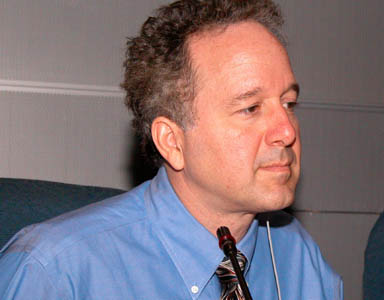
|
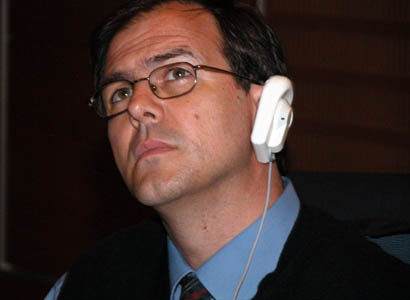
|
|
Lead
Author Ken Caldeira noted that the consequences of the equilibration between carbon dioxide in the ocean and atmosphere were nuanced and difficult to express in the SPM.
|
After
further comments from CHILE, NEW ZEALAND and GERMANY regarding
clarification of the process and time scale of equilibration,
the text introduced by Co-Chair Metz was accepted.
Above photo: Javier Garcia (Chile)
|
|
|
|
|
|
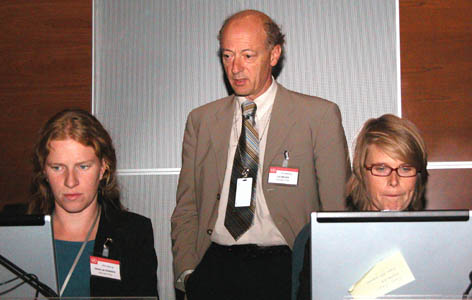
|
 |
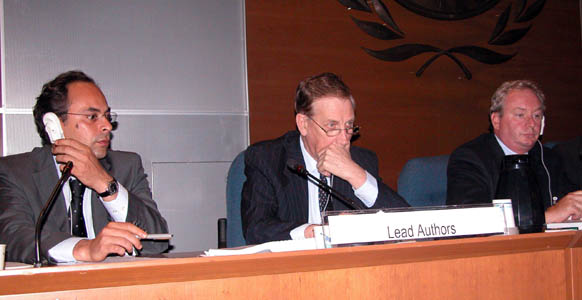
|
|
|
Above photos L-R: IPCC Secretariat staff members Heleen de
Connick, Leo Meyer and Monique Hoogwijk; Co-Chair Ogunlade Davidson (Sierra Leone)
Co-Chair
Bert Metz (The Netherlands), Leo Meyer (IPCC) and
Lead Author Ed Rubin; Lead Authors Keywan
Riahi, Peter Cook and John Gale.
|
|
|
|
|

|

|
|
Co-Chair Davidson introduced the revised text on the reaction of carbon dioxide with metal oxides, and noted that while the technology is still in the research phase, certain applications
using waste streams are in the demonstration phrase.
|
Discussion then shifted to text on industrial uses of carbon dioxide, which included a proposal by Canada, supported by the US, to insert text that
notes that enhanced oil recovery (EOR) is excluded from a statement that the potential for industrial uses of carbon dioxide is small.
Above photo: Trigg Talley (US)
|
|
|
|
|
|
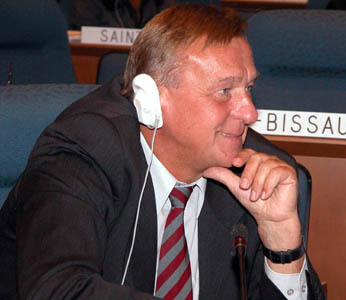
|
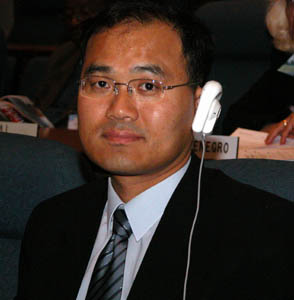
|
|
GERMANY noted that including such a reference could falsely suggest that EOR is a large opportunity.
Above photo: Wolfgang Müller (Germany)
|
JAPAN and KOREA proposed changing the reference to ocean storage direct injection "dissolution type"
and "lake type" in the table outlining the current maturity of CCS system
components
Above photo: Seong-Gil Kang (Republic of Korea)
|
|
|
|
|
What is the geographical relationship between the sources and storage opportunities for carbon dioxide?
|
|
Discussion for geological storage
focused on the type of sources, the distance from sources to storage locations, and the location of sources.
|
|
|

|
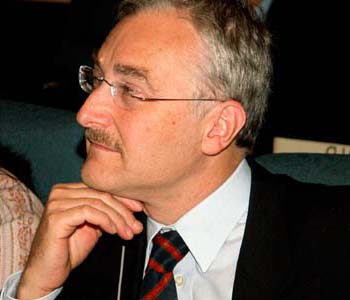
|
|
Discussion on ocean storage focused on ocean storage's regional distribution, maturity, location, and existing literature. JAPAN underscored that the ocean storage potential varies regionally,
and that Japan has more potential for ocean than geological storage.
Above photo: Toshiyuki Sakamoto (Japan)
|
AUSTRIA, AUSTRALIA and others expressed concern that the language implied more technical maturity and scientific analysis for ocean storage than
actually exists.
Above photo: Klaus Radunsky (Austria)
|
|
|
|
|
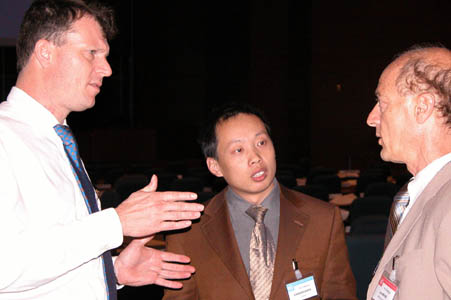
|
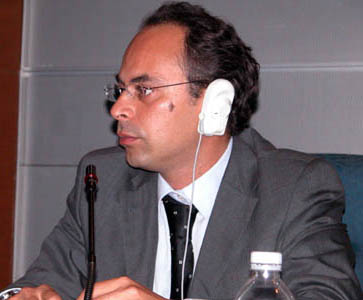
|
|
CHINA, supported by BANGLADESH, EGYPT and SAUDI ARABIA, and opposed by NORWAY and FINLAND, proposed emphasizing that the proximity of large point sources
to storage sites was
uncertain. Above photo L-R: Ronald Flipphi (The
Netherlands) in discussion with Kong Xiang Wen (China)
and Leo Meyer (IPCC)
|
On scenarios describing the potential for capture of global
fossil fuel carbon dioxide emissions by 2050, Lead Author Keywan Riahi clarified that
the SPM referred only to capture because there is a lack of literature on
the potential for storage.
|
|
|
|
|
|
ENB SNAPSHOTS: Reception hosted
by IPCC Secretariat on Thursday Evening
|
|
|
|
|
|
|
|
|

